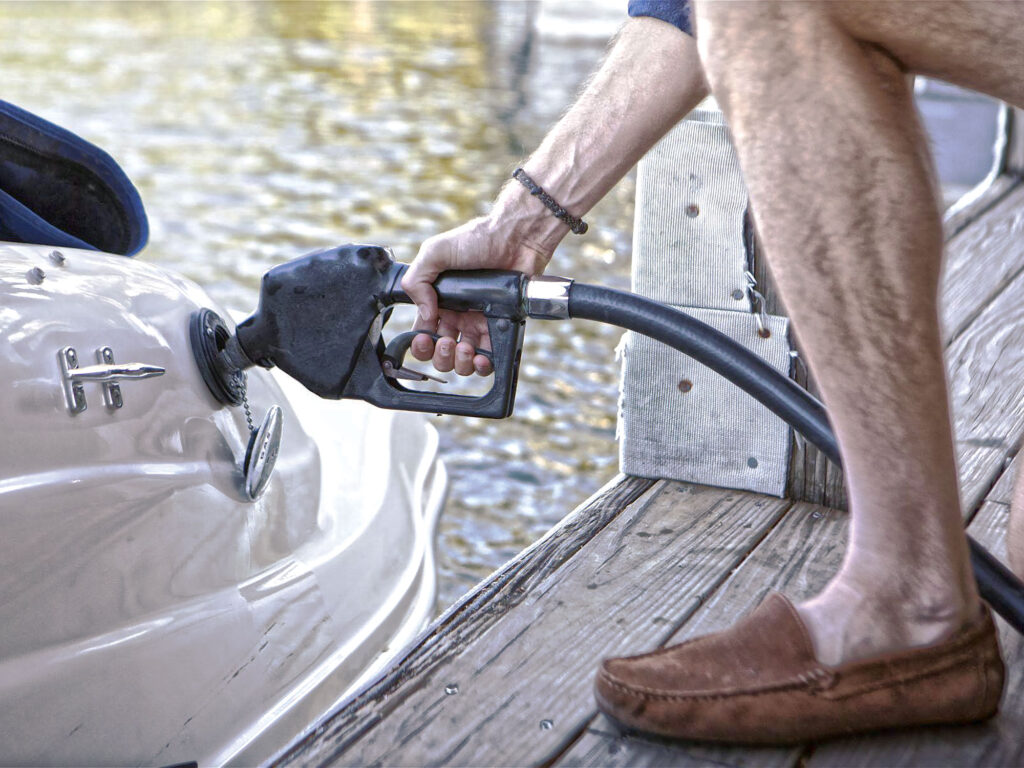SB Television
10 Do’s and Don’ts When Fueling Your Boat
 Proper fueling will keep your crew and boat safe.
Courtesy Water Sports Foundation
Proper fueling will keep your crew and boat safe.
Courtesy Water Sports Foundation
Fueling up is a basic component of boating. After all, if there’s no flow, there’s no go. But when was the last time you gave any thought to filling up at your local marina?
Recently I attended an American Boat & Yacht Council seminar on complying with H-24 fuel-system regulations. While the seminar focused mostly on the boatbuilding process, at the end, members of the panel—including experts from the US Coast Guard—held a brief discussion on safe fueling practices for recreational boaters. They shared more than one cautionary tale about how carefree fueling led to disaster, including fires and explosions.
So here are 10 tips for safely filling up your boat at the fuel dock. While these might seem a little “wash-behind-your-ears” basic, how many do you follow routinely?
1. Tie It OffI’ve seen many hurried boaters just loop around one midships cleat to tie off at the fuel dock. Best to tie off at the bow and the stern and put out fenders to minimize rock-and-roll, preventing jostling or spilling while handling the fuel pump.
2. Shut It DownBefore you reach for the nozzle, shut off everything that’s currently running on your boat. Obviously, the engine, but don’t forget any electronics—including the radio—and anything drawing from a power source, such as your air-conditioning unit. This will help prevent a stray current or spark from igniting fuel vapors.
3. Everybody OffUSCG and ABYC experts have both stressed the importance of having your entire crew exit the boat and remain on the dock during the fueling process. If something goes wrong, you’re much better off being away from the confines of the deck or boat cabin.
4. Port the PortablesIf you’re in a small boat with a portable fuel tank, remove the tank from the boat and fill it on the dock both to prevent spills on board and to guard against any static-
electricity buildup that could ignite fuel vapors.
Close up any open ports, deck hatches, cabin doors, and especially the engine compartment to prevent fuel vapors—which are heavier than air and sink—from entering into enclosed spaces.
6. Stay in ContactWhether you’re refueling the boat yourself or there’s a dockhand, always make sure someone has a hand on the nozzle. This will help prevent overflow and spillage, and also ensures that someone has eyes on the boat at all times.
7. Open the HatchesWhen you’re done fueling, open up the engine compartment and any doors or ports to ventilate the boat in case any fuel vapors found their way into enclosed spaces.
8. Blow it OutFor sterndrive and inboard boats, run the blower for five minutes before starting up to rid the engine compartment of any trapped gasoline fumes.
Read Next: The Importance of Monitoring Fuel Levels While Boating
9. Spill SafetyIf you do happen to spill gasoline on your boat while fueling, make sure to thoroughly clean it with absorbent pads. For major spills, move the boat away from the fuel dock without starting it and make sure to clean up the entire spill, even if it means canceling or postponing your trip. Call in experts if you need to.
10. Sniff TestBefore firing up the engine, give all enclosed compartments a sniff to check for any fumes that could have penetrated inside. If you notice the strong smell of gasoline inside, don’t turn the key or press the ignition button.
Bonus Tip: If you mistake your freshwater fill or pump-out fitting for the fuel fill and start pumping it with unleaded gas, call it a day and get a professional to clean your system before boating again. You may have to replace the entire system, but a boat in dry dock is better than a boat in flames.
The post 10 Do’s and Don’ts When Fueling Your Boat appeared first on Boating Mag.
- Home
- About Us
- Write For Us / Submit Content
- Advertising And Affiliates
- Feeds And Syndication
- Contact Us
- Login
- Privacy
All Rights Reserved. Copyright , Central Coast Communications, Inc.